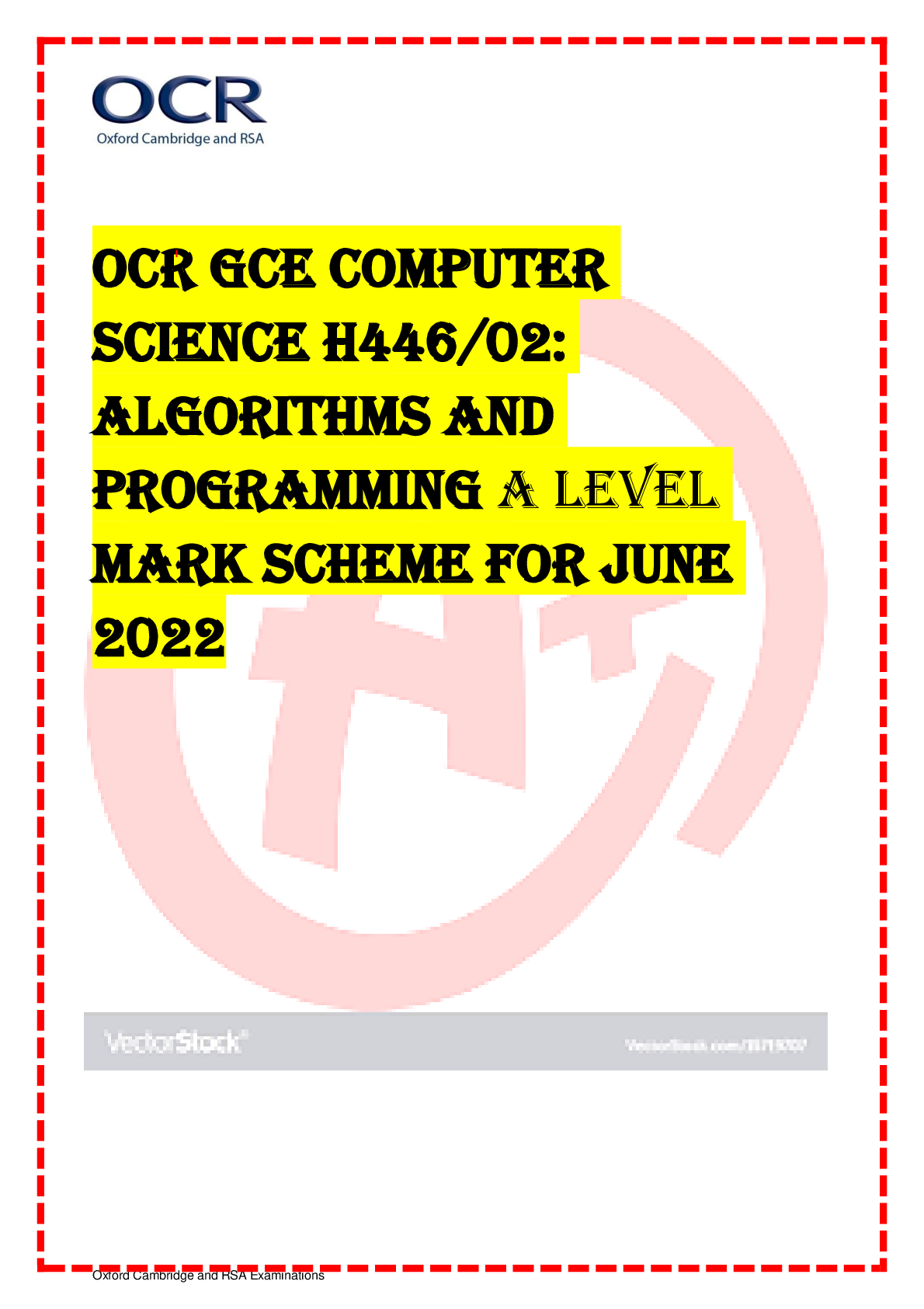Computer Science > AS Mark Scheme > GCE Computer Science H446/01: Computer systems Advanced GCE Mark Scheme for November 2020 (All)
GCE Computer Science H446/01: Computer systems Advanced GCE Mark Scheme for November 2020
Document Content and Description Below
Oxford Cambridge and RSA Examinations GCE Computer Science H446/01: Computer systems Advanced GCE Mark Scheme for November 2020Oxford Cambridge and RSA Examinations OCR (Oxford Cambridge and RSA... ) is a leading UK awarding body, providing a wide range of qualifications to meet the needs of candidates of all ages and abilities. OCR qualifications include AS/A Levels, Diplomas, GCSEs, Cambridge Nationals, Cambridge Technicals, Functional Skills, Key Skills, Entry Level qualifications, NVQs and vocational qualifications in areas such as IT, business, languages, teaching/training, administration and secretarial skills. It is also responsible for developing new specifications to meet national requirements and the needs of students and teachers. OCR is a not-for-profit organisation; any surplus made is invested back into the establishment to help towards the development of qualifications and support, which keep pace with the changing needs of today’s society. This mark scheme is published as an aid to teachers and students, to indicate the requirements of the examination. It shows the basis on which marks were awarded by examiners. It does not indicate the details of the discussions which took place at an examiners’ meeting before marking commenced. All examiners are instructed that alternative correct answers and unexpected approaches in candidates’ scripts must be given marks that fairly reflect the relevant knowledge and skills demonstrated. Mark schemes should be read in conjunction with the published question papers and the report on the examination. © OCR 2020H446-01 Mark Scheme November 2020 Annotations Annotation Meaning Omission mark Benefit of the doubt Subordinate clause / consequential error Incorrect point Expansion of a point Follow through Not answered question No benefit of doubt given Point being made Repeat Correct point Too vague Zero (big) Blank Page – this annotation must be used on all blank pages within an answer booklet (structured or unstructured) and on each page of an additional object where there is no candidate response. Level 1H446-01 Mark Scheme November 2020 Question Answer Mark Guidance 1 (a) i • Client computers connect to server • Server provides access to a resource/service • In this case hotel staff use client computers to connect to database on server (or other sensible example). 3 AO1.2 ii e.g. • only one point of failure • easier to manage users/access • Easier to backup • Easier to keep data secure. • Technicians can more easily remotely install / monitor. 2 AO1.1 (b) • Joins computers/devices together on a LAN • Receives packets/data • Recipient’s address is given in packet header/it uses the mac address • Send packets/data • Out the correct port /to the specific computer device 3 AO1.1 Level 2 Level 3H446-01 Mark Scheme November 2020 (c) Mark Band 3–High Level (7-9 marks) The candidate demonstrates a thorough knowledge and understanding of network security. The material is generally accurate and detailed. The candidate is able to apply their knowledge and understanding directly and consistently to the context provided. Evidence/examples will be explicitly relevant to the explanation. The candidate provides a thorough discussion which is well balanced. Evaluative comments are consistently relevant and well-considered. There is a well-developed line of reasoning which is clear and logically structured. The information presented is relevant and substantiated. Mark Band 2-Mid Level (4-6 marks) The candidate demonstrates reasonable knowledge and understanding of network security; the material is generally accurate but at times underdeveloped. The candidate is able to apply their knowledge and understanding directly to the context provided although one or two opportunities are missed. Evidence/examples are for the most part implicitly relevant to the explanation. The candidate provides a sound discussion, the majority of which is focused. Evaluative comments are for the most part appropriate, although one or two opportunities for development are missed. There is a line of reasoning presented with some structure. The information presented is in the most part relevant and supported by some evidence. 9 AO1.1 (2) AO1.2 (2) AO2.1 (2) AO3.3 (3) AO1 Malware and viruses are software that can have a negative impact on computer systems Spyware and keyloggers can record information entered and send back to a third party Phishing attacks attempt to steal data by fraudulently appearing as legitimate emails asking for secure information Denial of Service Attacks can overload a computer system with traffic and effectively disable access for legitimate users AO2 Hotel’s systems could be disrupted by DDOS attacks so no external bookings able to be made. Phishing and spyware attacks may compromise visitor security and result in financial loss Malware, viruses could destroy hotel data Theft of customer data would be an issue under Data Protection Act / GDPR for which the hotel could be prosecuted AO3 Education for staff and customers is important to deal with recognising and dealing with threats Up to date software, limitations of use of devices such as USB sticks and restricted access to wireless networks can all limit risks. Use of Firewall to restrict traffic entering and leaving the network. Should be balanced against customer experience; will customers return if they have no access to It facilities?H446-01 Mark Scheme November 2020 Mark Band 1-Low Level (1-3 marks) The candidate demonstrates a basic knowledge of network security; the material is basic and contains some inaccuracies. The candidate makes a limited attempt to apply acquired knowledge and understanding to the context provided. The candidate provides a limited discussion which is narrow in focus. Judgments if made are weak and unsubstantiated. The information is basic and communicated in an unstructured way. The information is supported by limited evidence and the relationship to the evidence may not be clear. 0 marks No attempt to answer the question or response is not worthy of credit. (d) i -Customer, Room and Booking entities, must be singular -Customer joined to Booking and Room joined to booking and no other links -Customer to Booking relationship indicated as onemany -Room to Booking relationship indicated as onemany 4 AO2.2 Ii • A field that links to a (primary) key in a second table • Example : Customer ID // RoomID… • … in Booking table 3 AO1.1 (1) AO2.1 (2)H446-01 Mark Scheme November 2020 iii • Hashing for security • …e.g. hash passwords in database • …to make sure they cannot be read if they are stolen • Hashing for direct access • …e.g. Customer/Room/Booking records can be quickly accessed • …by using hash of index as address 4 AO1.2 (2) AO2.2 (2) (e) • Database/relationships are consistent // each foreign key links to an existing/valid primary key • Suitable example of being broken (e.g. if primary key is deleted/updated, foreign keys are no longer valid / changes should be cascaded) 2 AO1.1 (1) AO1.2 (1) Accept example that is not related to the database given (as this is an AO1 question)H446-01 Mark Scheme November 2020 Question Answer Mark Guidance 2 (a) (i) • Constructor method definition (.e.g new) • itemname, price passed in as parameters (must use different identifier names to the ones in the question) • …and assigned to attributes • discount attribute assigned to 0. 4 AO3.2 Example answer public procedure new(nItemName, nPrice) itemname = nItemname price = nPrice discount = 0 endprocedure Look out for alternative notation e.g. this.itemname = itemName (ii) • 1 mark for creating object with identifier mushypeas = • 1 mark for creating object as type ItemForSale • mark for parameters passed in as needed 3 AO3.2 Example answers mushypeas=new ItemForSale("mushy peas", 0.89) ItemForSale mushypeas = ItemForSale(“mushy peas”,0.89); mushypeas=ItemForSale((“mushy peas”,0.89); Do not penalise for use of self parameter as used by languages such as Python. Must be correct case and spelling (iii) • method definition for calculatePrice() • applies percentage discount • …returns calculated value 3 AO3.2 Percentage discount must be applied correctly. Example answer function calculatePrice() newPrice = price – (price * discount/100) return newPrice end function 2 (b) • discount attribute made private • Set method created • …that restricts value to maximum 50% 3 AO2.2 2 (c) • Create new class 4H446-01 Mark Scheme November 2020 • …inheriting from / subclass of ItemsForSale • new attribute for stock location • calculatePrice() method overridden // new version of calculatePrice() implemented in subclass. AO2.2H446-01 Mark Scheme November 2020 Question Answer Mark Guidance 3 (a) i 1000 1001 1 AO1.2 Correct answer only 3 ii 6D 1 AO1.2 Correct answer only 3 iii AB 1 AO1.2 Correct answer only 3 iv 1010 0110 1 mark per nibble 2 AO1.2 Correct answer only 3 (b) • 10110.111 in fixed point • Move binary point four places to the left (1.0110111) • Gives mantissa of 10110111 • therefore exponent is 4 = 0100 • Forming final answer of 10110111 0100 5 AO1.2 3 (c) (i) • 1001 1010 2 AO1.2 1 mark per nibble, mark left to right (ii) • 1000 0000 • OR 2 AO2.2H446-01 Mark Scheme November 2020 Question Answer Mark Guidance 4 (a) i • left column filled with 1s (¬ A ∧ ¬ B) … • right column filled with 1s ( A ∧ ¬ B)… • …Middle 2 columns filled with zero or blank 3 AO1.2 (1) AO2.2 (2) 4 ii • ¬ B / NOT B • Karnaugh map used to show 1s highlighted with overlap 2 AO2.2 4 (b) i • Delay / store a value… • …of 1 bit • When a signal is given 2 AO1.1 4 (b) Ii • Data input • Clock input 4H446-01 Mark Scheme November 2020 • Q output • When clock input goes high… • …Q changes to D • NOT Q is reverse of Q AO1.1 (2) AO1.2 (2)H446-01 Mark Scheme November 2020 Question Answer Mark Guidance 5 Mark Band 3–High Level (7-9 marks) The candidate demonstrates a thorough knowledge and understanding of electronic communication monitoring techniques and the social and legal impact of this. The material is generally accurate and detailed. The candidate is able to apply their knowledge and understanding directly and consistently to the context provided. Evidence/examples will be explicitly relevant to the explanation. The candidate provides a thorough discussion which is well balanced. Evaluative comments are consistently relevant and well-considered. There is a well-developed line of reasoning which is clear and logically structured. The information presented is relevant and substantiated. Mark Band 2-Mid Level (4-6 marks) The candidate demonstrates reasonable knowledge and understanding electronic communication monitoring techniques and the social and legal impact of this; the material is generally accurate but at times underdeveloped. The candidate is able to apply their knowledge and understanding directly to the context provided although one or two opportunities are missed. Evidence/examples are for the most part implicitly relevant to the explanation. The candidate provides a sound discussion, the majority of which is focused. Evaluative comments are for the most part appropriate, although one or two opportunities for development are missed. 9 AO1.1 (2) AO1.2 (2) AO2.1 (2) AO3.3 (3) AO1 Encryption means that data is scrambled so that if it is intercepted, it cannot be understood. Requires the use of a key to decrypt. Symmetric encryption uses on key for encrypt/decrypt and so key exchange is problematic. Asymmetric encryption uses different keys (public and private) so no need to exchange keys. Regulation of Investigatory Powers Act (RIPA) gives authorities the power to compel disclosure of encryption keys AO2 Encrypted messages cannot be read by outsiders without the key RIPA gives Police the power to insist on users decrypting messages / handing over the key to allow reading of messages. Many messaging services already include end-to-end encryption by default Use of VPNs to re-route traffic and attempt to escape monitoring possible The ending of encrypted data shows that two parties are passing information they want to keep secret. Techniques like steganography can be used to his the existence of encrypted data. AO3 Monitoring communication runs the risk of revealing secret but non-illegal communications Restricting encryption means that secure sites (eg banks) may struggle to function Legislation (RIPA) already ensures that communications can be monitored if there is just cause Routine monitoring runs the risk of false-positives However, will reduce risk of illegal activities being coordinated (e.g. terrorism, drug trafficking).H446-01 Mark Scheme November 2020 There is a line of reasoning presented with some structure. The information presented is in the most part relevant and supported by some evidence. Mark Band 1-Low Level (1-3 marks) The candidate demonstrates a basic knowledge of electronic communication monitoring techniques and the social and legal impact of this; the material is basic and contains some inaccuracies. The candidate makes a limited attempt to apply acquired knowledge and understanding to the context provided. The candidate provides a limited discussion which is narrow in focus. Judgments if made are weak and unsubstantiated. The information is basic and communicated in an unstructured way. The information is supported by limited evidence and the relationship to the evidence may not be clear. 0 marks No attempt to answer the question or response is not worthy of credit.H446-01 Mark Scheme November 2020 Question Answer Mark Guidance 6 (a) • Stores current player • …and alternates between player on each go • Allows a number to be input • …and validates that this is between 1 and 3 • Outputs numbers chosen (e.g. 4, 5, 6) • Checks if number 15 has been reached • …and displays winning message • …and stops 8 AO3.2 Example answer num = 1 turn = "player 1" while num <= 15 print(turn + "'s turn") choice = input("how many numbers?") if choice >= 1 and choice <= 3 then for y = 1 to choice print(num) num = num + 1 next y //swap turn if turn == "player 1" then turn = "player 2" else turn = "player 1" end if end if endwhile print(turn + " wins!")H446-01 Mark Scheme November 2020 Question Answer Mark Guidance 7 (a) • Store value in accumulator at address given • BRA // BR • Branch if zero • Branch if zero or positive • HLT // COB // END 5 AO1.1 Mnemonic Instruction ADD Add SUB Subtract STA Store value in accumulator at address given LDA Load (to accumulator) BRA Branch always BRZ Branch if zero BRP Branch if zero or positive INP Input OUT Output HLT End program 7 (b) • Inputs two numbers • ..stores at least one of them • Comparison / subtraction to decide which is larger • Jump / output if num1 larger • Jump / output if num2 larger or nums equal • Loops back to start after either output 6 AO3.2 Example answer start INP STA x INP STA y SUB x BRP first LDA x OUT BRA start first LDA y OUT BRA start x DAT y DATH446-01 Mark Scheme November 2020 Question Answer Mark Guidance 8 (a) Mark Band 3–High Level (9-12 marks) The candidate demonstrates a thorough knowledge and understanding of procedural and object oriented programming. The material is generally accurate and detailed. The candidate is able to apply their knowledge and understanding directly and consistently to the context provided. Evidence/examples will be explicitly relevant to the explanation. The candidate provides a thorough discussion which is well balanced. Evaluative comments are consistently relevant and well-considered. There is a well-developed line of reasoning which is clear and logically structured. The information presented is relevant and substantiated. Mark Band 2-Mid Level (5-8 marks) The candidate demonstrates reasonable knowledge and understanding of procedural and object oriented programming; the material is generally accurate but at times underdeveloped. The candidate is able to apply their knowledge and understanding directly to the context provided although one or two opportunities are missed. Evidence/examples are for the most part implicitly relevant to the explanation. The candidate provides a sound discussion, the majority of which is focused. Evaluative comments are for the most part appropriate, although one or two opportunities for development are missed. 12 AO1.1 (2) AO1.2 (2) AO2.1 (23 AO3.3 (5) AO1 Object oriented programming makes use of classes (templates) from which objects are made. Classes have attributes and methods Classes can be encapsulated by making attributes private and providing public access methods Object oriented programming supports inheritance which allows classes to use attributes and methods of parent classes. Object oriented programming supports polymorphism meaning that class attributes and methods can take on many different forms if required. AO2 OO approach would call on classes per type of player or enemy object Objects made from these classes, so one enemy class may generate many enemy objects, each with different values for their attributes (e.g. speed, energy) Special types of Player or Enemy objects could be instantiated from classes that inherit from the original Player/Enemy classes, but have attributes/methods of their own. Polymorphism would allow for the attributes/methods of Player/Enemy objects to behave differently from normal if required. AO3 OO promotes a modular approach (procedural through use of subroutines, OO through classes). OO is an abstraction of a real world problem, with classes for each type of things to be modelled and objects for each instance of these. OO has advantages in data security in that encapsulation forces developers/users to use methodsH446-01 Mark Scheme November 2020 There is a line of reasoning presented with some structure. The information presented is in the most part relevant and supported by some evidence. Mark Band 1-Low Level (1-4 marks) The candidate demonstrates a basic knowledge of procedural or object oriented programming; the material is basic and contains some inaccuracies. The candidate makes a limited attempt to apply acquired knowledge and understanding to the context provided. (with their built in validation) to access/amend data stored in attributes. OO has advantages in efficiency of design where classes can be reused and can inherit from one another. Procedural programming struggles to support this. OO also offers flexibility through polymorphism.H446-01 Mark Scheme November 2020 Question Answer Mark Guidance 9 (a) i • Paging • …blocks of memory of equal size / fixed size • Segmentation • …blocks of memory split logically /variable size 4 AO1.2 ii e.g. • Security • …does not let programs access memory reserved for other programs. • Multitasking • ...allows multiple programs to run at once 2 AO1.2 iii • (Currently unneeded) pages moved from memory to secondary storage • …to create room in memory • pages moved back to memory when required 2 AO1.1 (b) • Software/program • …that allows the operating system to communicate with hardware Examples: • Printer driver • Webcam driver • Sound card driver • Graphics card driver etc. 3 AO1.1 (1) AO2.1 (2) Max two for description, Max one for example (c) e.g. • Encryption • …scrambles meaning of data files with a key • Defragmentation • …organises file segments on secondary storage • Compression • … reduces size of files • Backup • …makes regular copies of files in case of loss • Disk Checker 4 AO1.1 Mark in pairs, 2 marks per example. Accept other sensible examples of utility software. (d) i • Source code / program code is freely available • …to edit/amend recompile. 2 AO1.1H446-01 Mark Scheme November 2020 ii e.g. • Can modify code and adapt IDE to her needs • Is likely to be financially free of cost. • Can recompile to work on different systems • Has the benefit of a community potentially improving the system • Can learn from others • Can ensure no backdoors / malware 1 AO2.1 Do not accept simply seeing the code (previous question). (e) i • Sections of code / program file • Written by other authors / already written • Containing useful routines • Suitable example (e.g. GUI routines, database access routine, encryption, graphics) 3 AO1.1 (2) AO2.1 (1) Maximum 2 for definition, 1 for example ii • Save time… • …because no need to rewrite code • Use expertise of others.. • …to complete tasks that require specialist knowledge / abstract away complexity. • Has already been tested/the programmer doesn’t have to test it themselves • Making debugging easier/saving time 2 AO1.2 iii • May (significantly) increase size of compiled file… • …as library contains many routines that aren‘t being used. • Not written by the programmer • …so introduces uncertainty / require further testing / programmer needs to spend time familiarising themselves with it 2 AO1.2 iv • Links the main program to libraries • ..can either include them in the final executable code • ..or get the executable code to point to the external libraries • 3 \ AO1.2 Accept terms static and dynamic for bullets 2 and 3, but only if these are explained.OCR (Oxford Cambridge and RSA Examinations) The Triangle Building Shaftesbury Road Cambridge CB2 8EA [Show More]
Last updated: 1 year ago
Preview 1 out of 21 pages
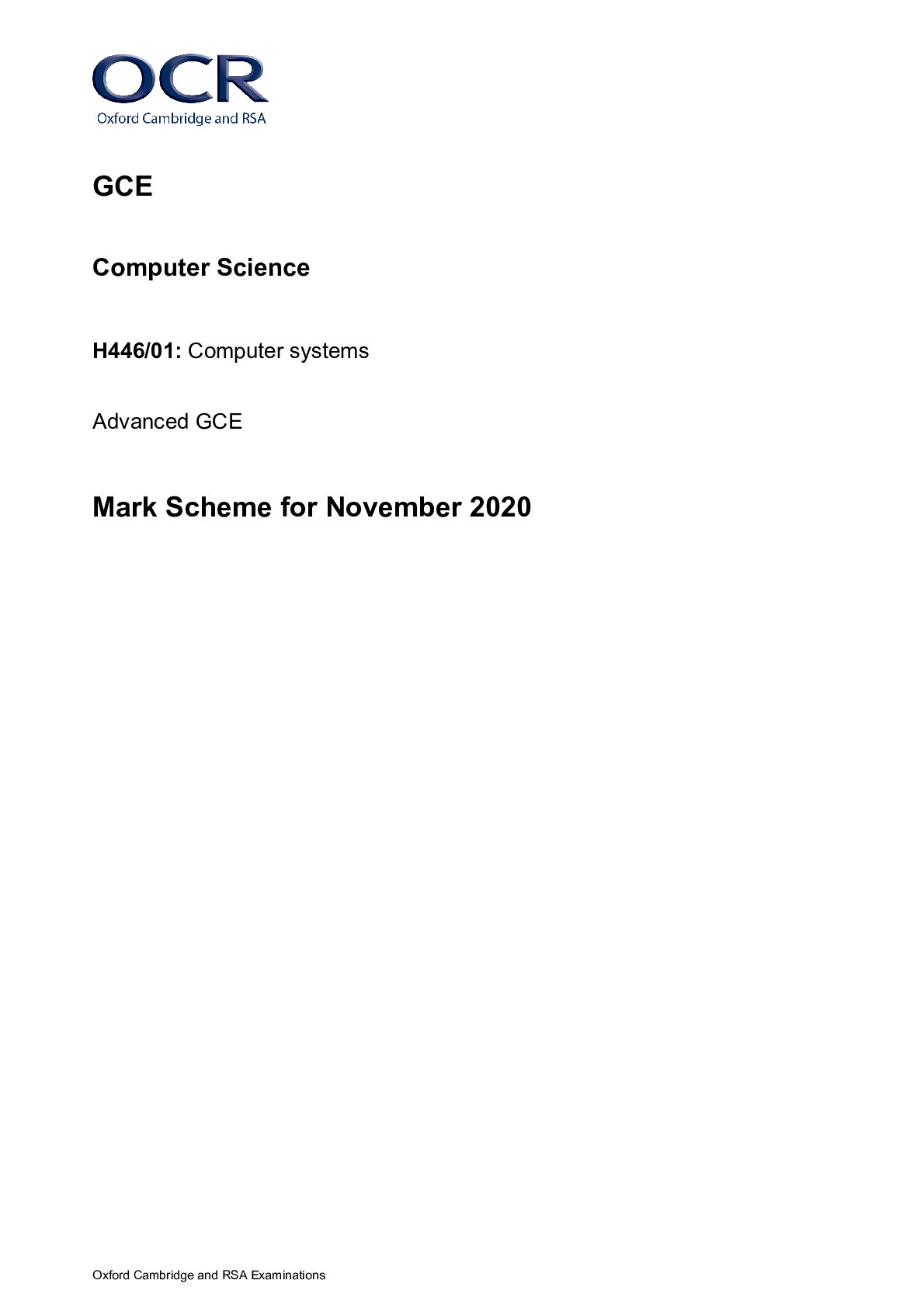
Reviews( 0 )
Document information
Connected school, study & course
About the document
Uploaded On
Oct 10, 2022
Number of pages
21
Written in
Additional information
This document has been written for:
Uploaded
Oct 10, 2022
Downloads
0
Views
61








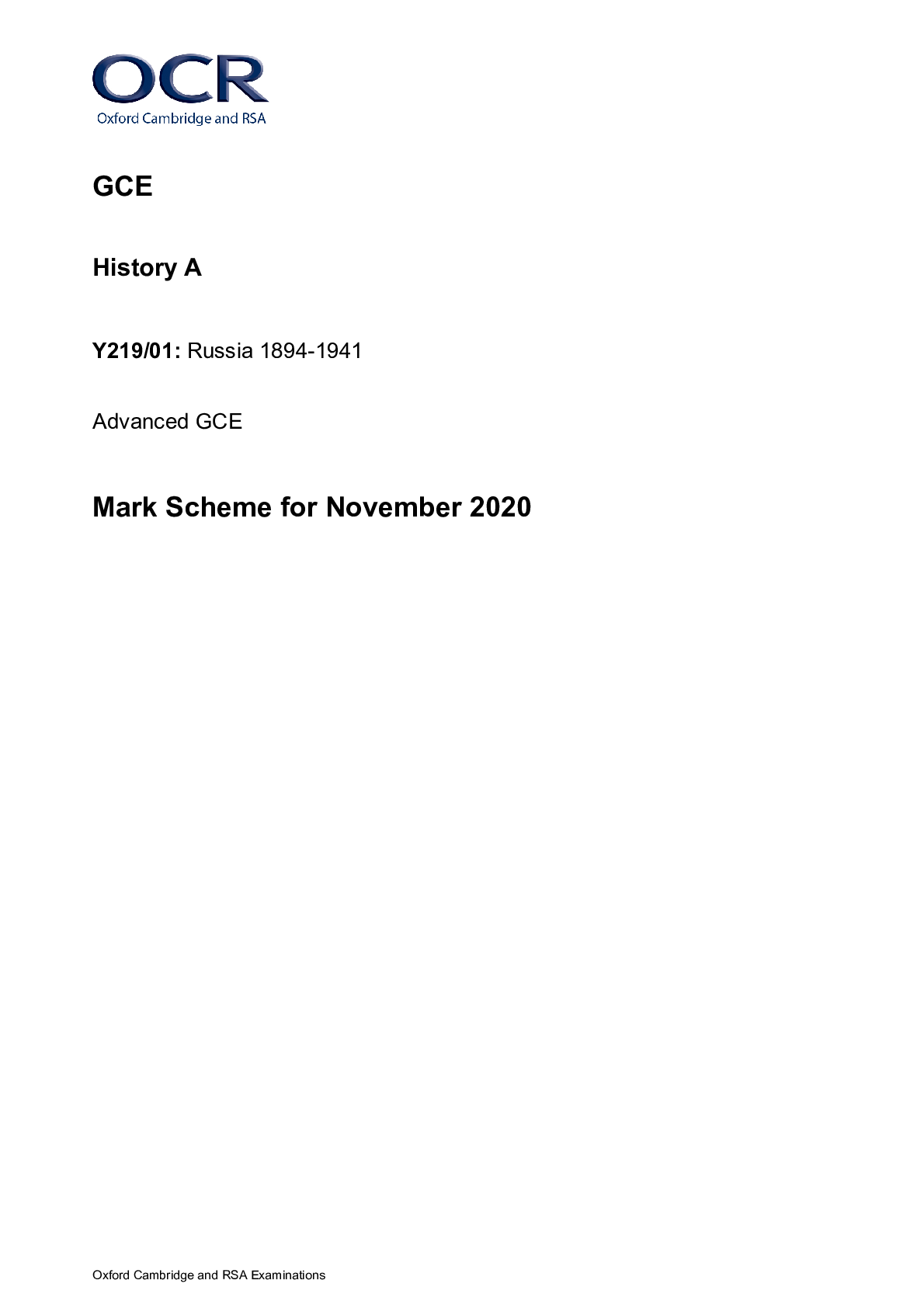
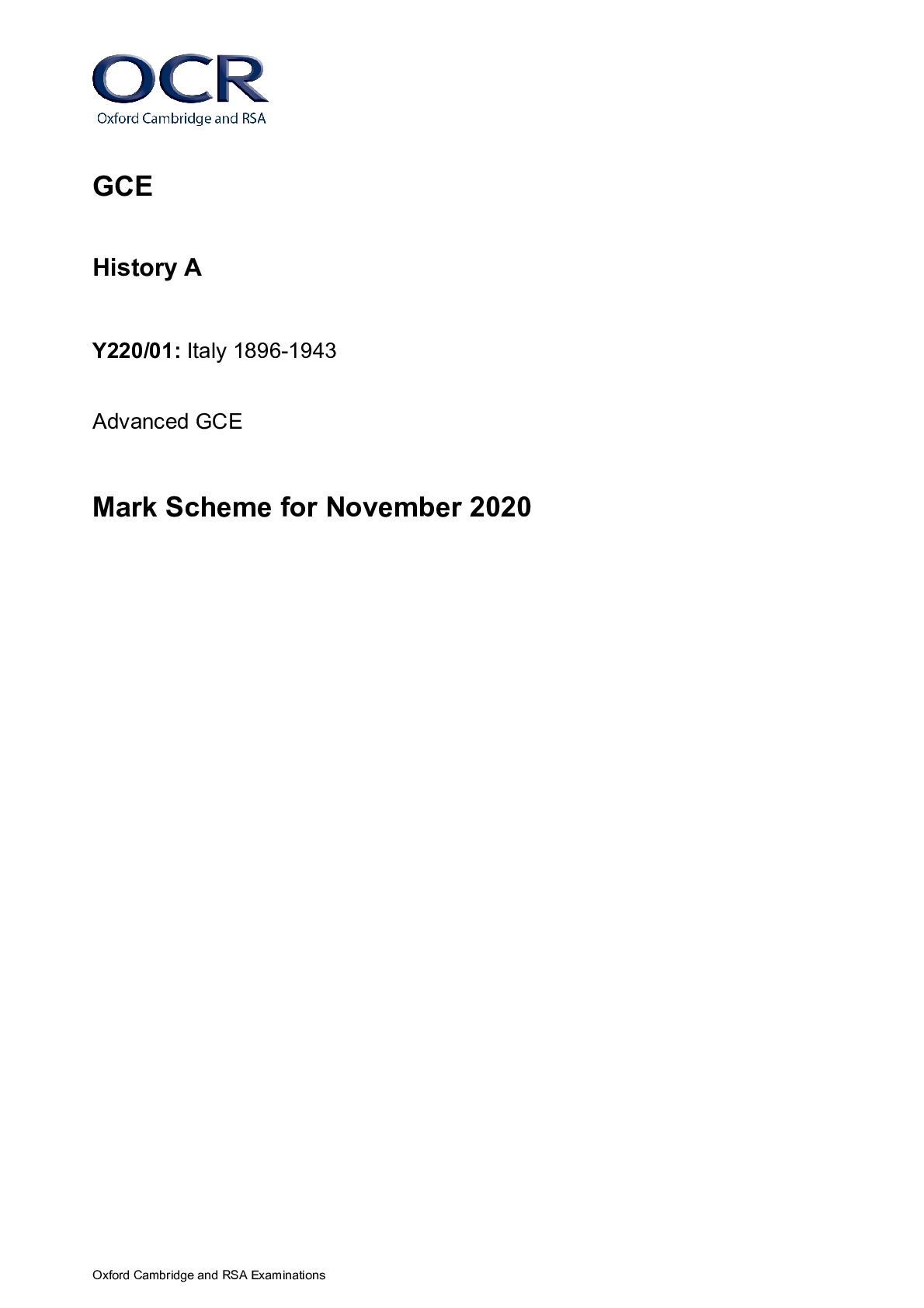

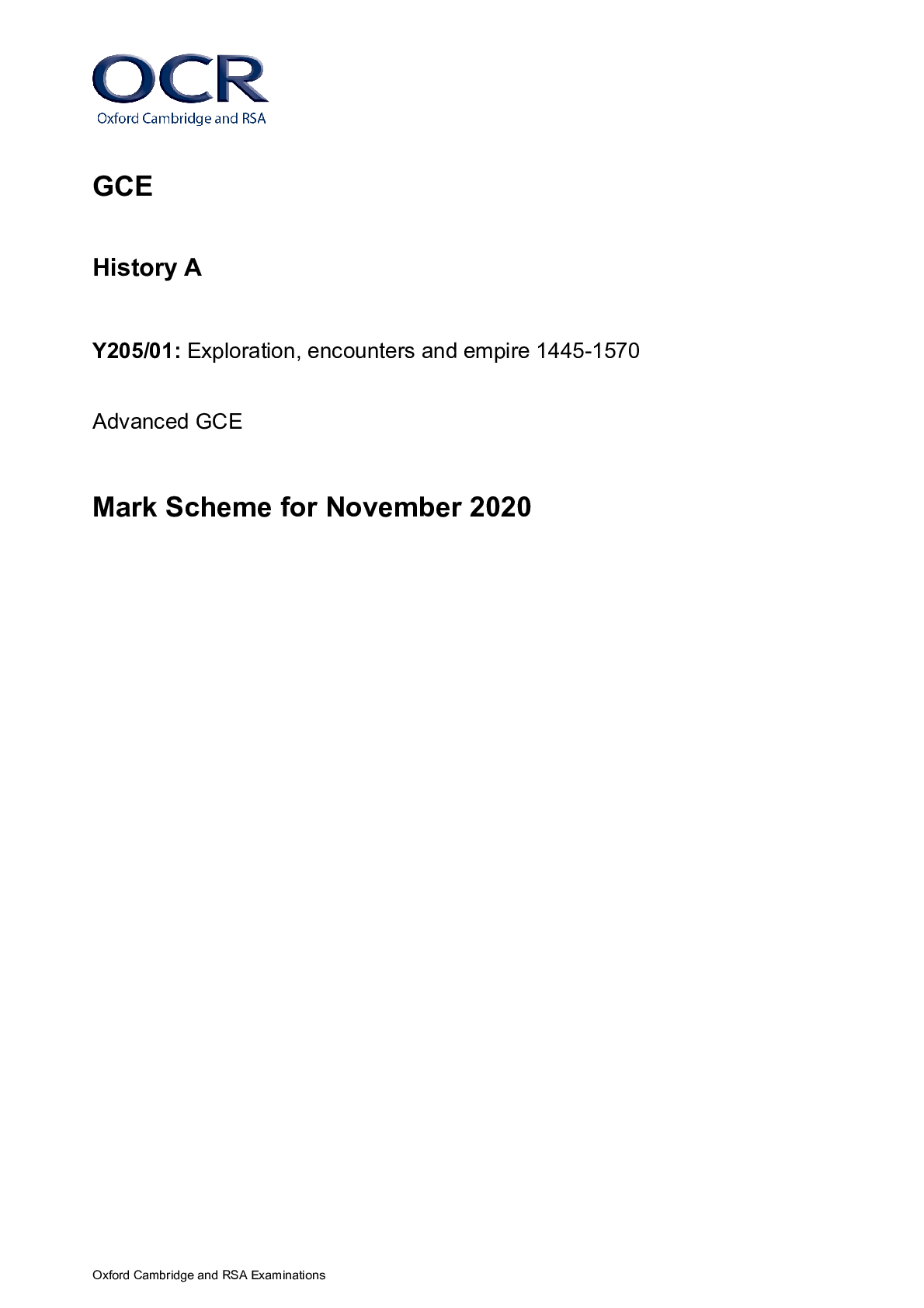
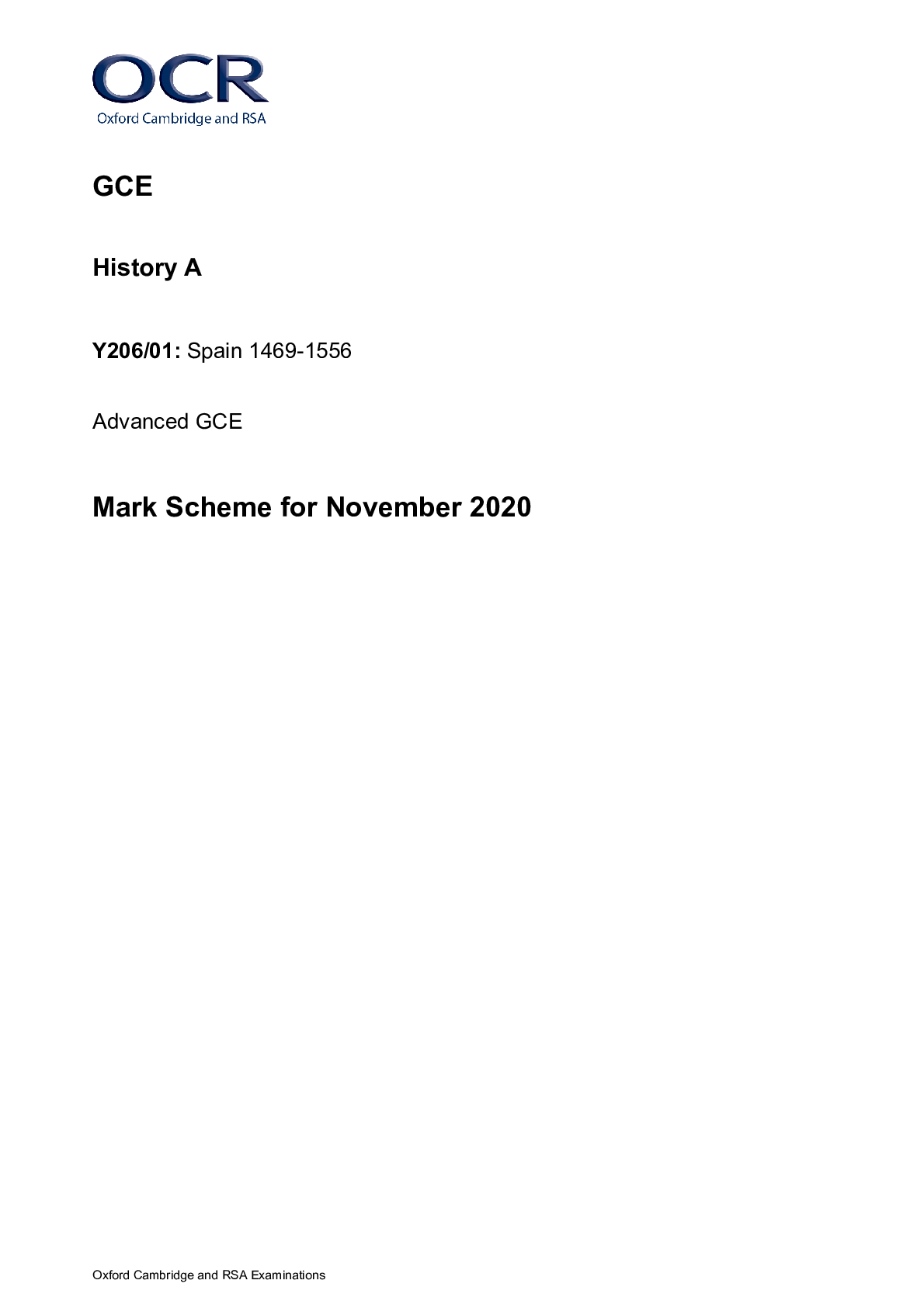
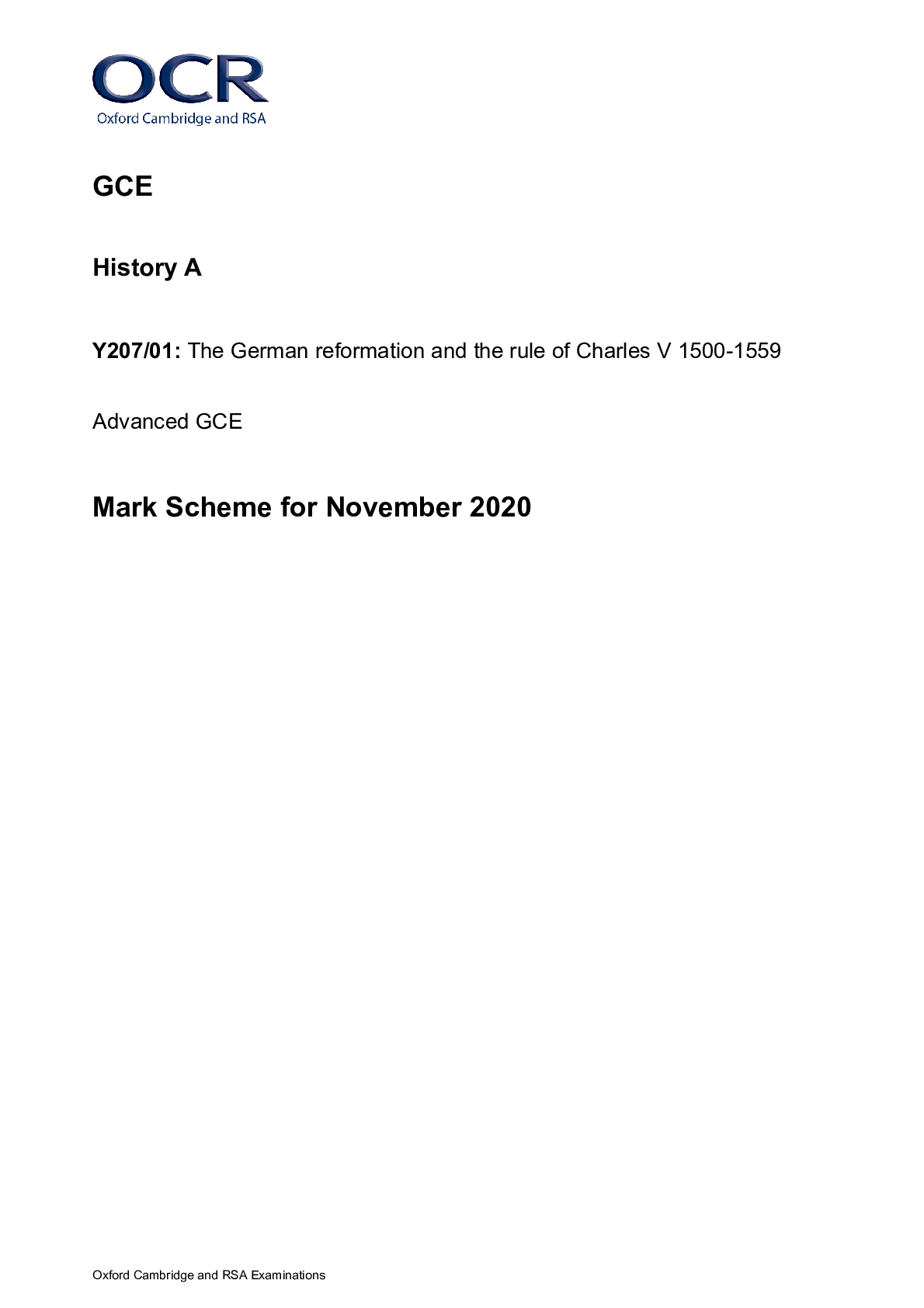


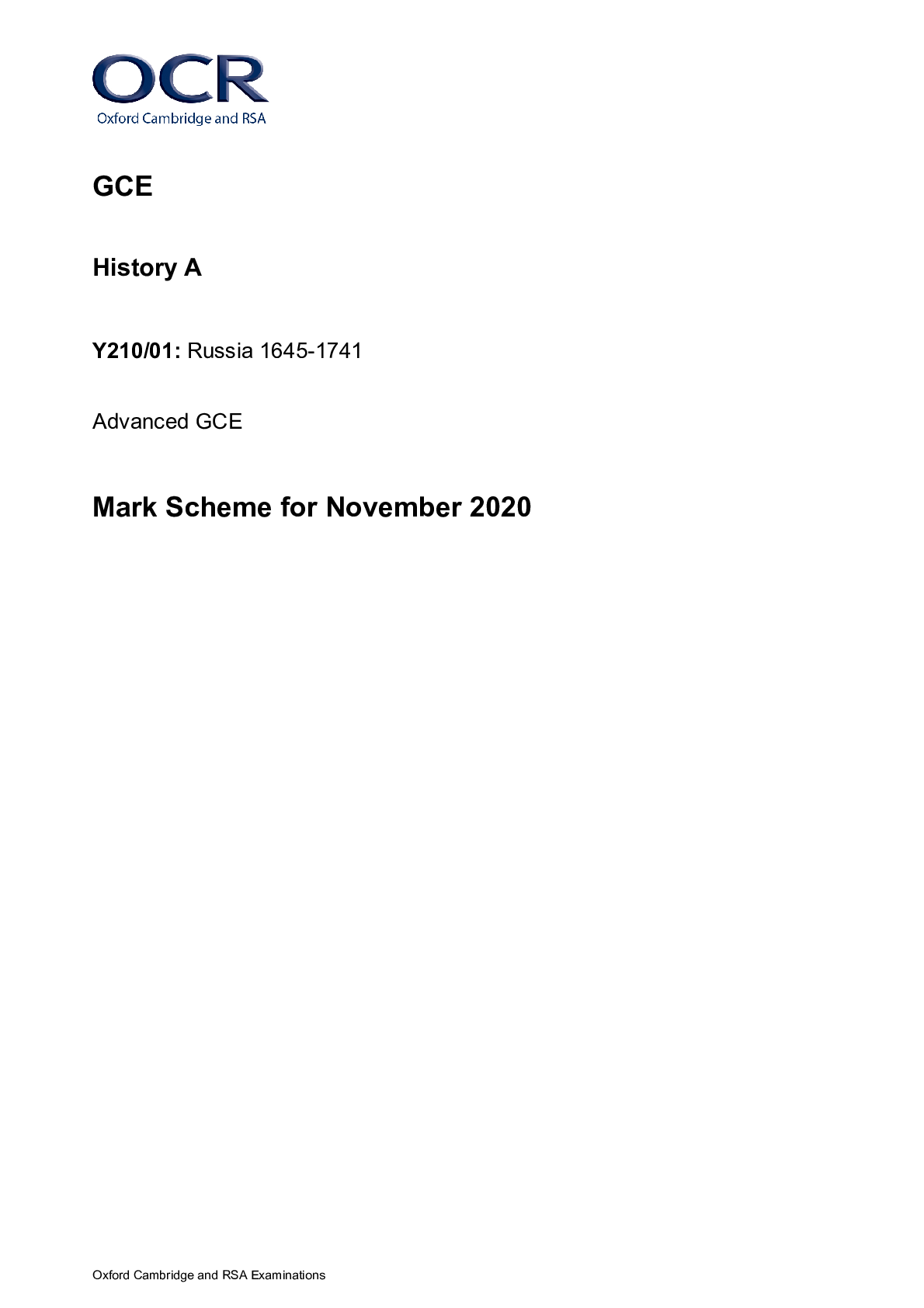


.png)



